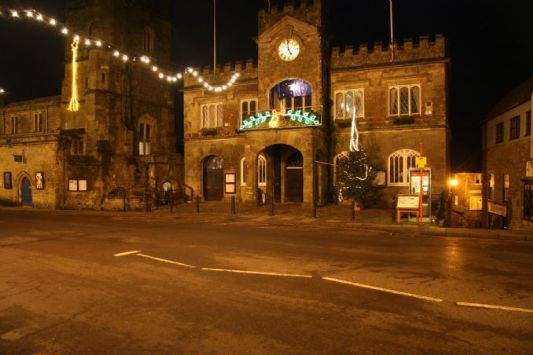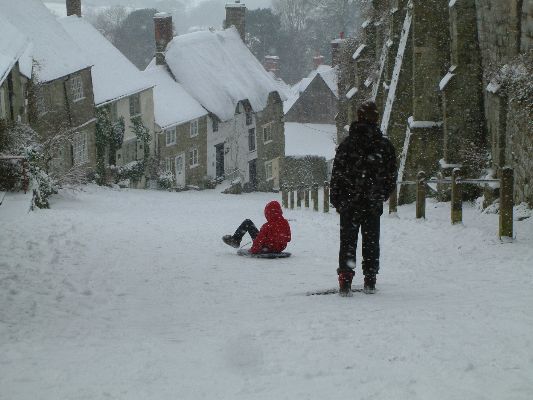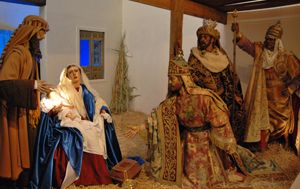 Christmas plays well in Dorset market towns, especially Shaftesbury. The stone parish church and the charming town hall sit comfortably at the centre of lights and celebrations during late-night shopping. Santa, elves, the Shaftesbury Town Silver Band, chestnuts roasting on an open fire, and the community choir carolling in the crisp winter evening. It's Christmas in Dorset and all's right with the world.
Christmas plays well in Dorset market towns, especially Shaftesbury. The stone parish church and the charming town hall sit comfortably at the centre of lights and celebrations during late-night shopping. Santa, elves, the Shaftesbury Town Silver Band, chestnuts roasting on an open fire, and the community choir carolling in the crisp winter evening. It's Christmas in Dorset and all's right with the world.
 Except that I'm staring at a bag, sized to within a millimetre of Easyjet's rigorous cabin allowance. I'm packing a few presents and cards I've been given, a few presents and cards I'm giving, a china teapot, some Wensleydale cheese and my black choir outfit which inexplicably includes a reindeer headdress. Closing the door on the cosy thatched cottage which has hosted my last eleven Christmases and all the traditions of decorating that go with that. Leaving behind the boxes of Christmas stuff, all labelled - front porch, little lounge, big lounge. Everything had its pre-determined place. Instead, heading for Spain and the slightly daunting task of beginning a new set of Christmas traditions. The unknown. Nothing has a pre-determined place, including me.
Except that I'm staring at a bag, sized to within a millimetre of Easyjet's rigorous cabin allowance. I'm packing a few presents and cards I've been given, a few presents and cards I'm giving, a china teapot, some Wensleydale cheese and my black choir outfit which inexplicably includes a reindeer headdress. Closing the door on the cosy thatched cottage which has hosted my last eleven Christmases and all the traditions of decorating that go with that. Leaving behind the boxes of Christmas stuff, all labelled - front porch, little lounge, big lounge. Everything had its pre-determined place. Instead, heading for Spain and the slightly daunting task of beginning a new set of Christmas traditions. The unknown. Nothing has a pre-determined place, including me.
It's sunny in Spain, right? Expats dine outside all year round, and then in the winter when the evenings turn slightly chilly they slip on a cardigan for a last drink on the terrace before sitting cosily indoors watching Strictly Come Dancing, right? And all the while, friends and family back in the UK quietly agree with Government suggestions that the Winter Fuel Payment shouldn't be paid to Brits in Spain. Wrong. The days are bright and often sunny, lovely for crisp winter walks, but when the sun drops over the mountains the temperature plummets. Friends complain that their wood-burning stoves are guzzling fuel faster than a steam train. The tiled floors, though strewn with rugs, are chilly. We wear two pairs of socks, even in bed. Power cuts are frequent and tend to affect the whole village (and, according to addicts of "Strictly", occur most often on Saturday evenings).
So the wood-burner will be the focal point for the Spanish winter and therefore for my first Spanish Christmas. I found a tiny 1ft tinsel tree in the drawer of the bureau delivered from Dorset, and I have some baubles. And of course I have a vast supply of candles, in preparation for the power-cuts.  I am missing the ingredients to build a belén, the nativity scene that should take pride of place somewhere in my house. I have some ancient elves, passed down from my German grandmother, that could just about pass as shepherds. I have some green raffia paper. I could build something on the window ledge, to show willing. I can skip most of the normally-required characters, but I probably need some sort of stable-type contraption as the centrepiece.
I am missing the ingredients to build a belén, the nativity scene that should take pride of place somewhere in my house. I have some ancient elves, passed down from my German grandmother, that could just about pass as shepherds. I have some green raffia paper. I could build something on the window ledge, to show willing. I can skip most of the normally-required characters, but I probably need some sort of stable-type contraption as the centrepiece.
Christmas-shops. Will there be Christmas-shops? A December visit to Barcelona some years ago seemed to include Christmas-shops. Certainly there were shops selling caganers, the great Catalan "up yours" to whichever political figure is out of favour (this year it's Rajoy, of course). Perhaps December needs to include a trip to see the Málaga lights, and a day out in Granada. One of those will surely provide a small wooden stable?
My final dilemma is whether to give Ana and Julia, the little girls next door, their bags of chocolate coins on Christmas Day (the traditional, though historically incorrect, day of present-giving in the UK), or on Kings' Day (the traditional, and of course more logical, day of present-giving in Spain). I am leaning towards Christmas Day, which for them is not a special day, so I can explain how Christmas is done in the UK.
In the meantime, I have some time to explore how Christmas is done in Spain.
© Tamara Essex 2012